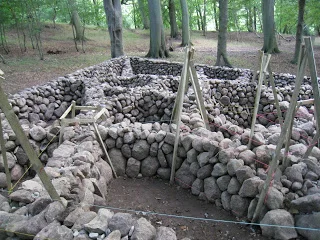Once again, dry stone construction has taken me around the seasons. Work that employed the simplest of means culminated in a complexity of projects and events. There were presentations, workshops, consultations and proposals. There were utilitarian constructions, memorials and art installations. There was even a grant awarded and inclusion in a magazine article and a book. The year in stone took me around New England, to other countries and back in time.
Read MoreThe subject of both talks focused on three questions: What makes sturdy dry stone constructions? Where does stone come from? Where do designs come from? In the second question, I pressed the point of seeking out alternatives to what has become the most common go-to place for stone procurement: The Home and Garden Center. I encouraged audience members to investigate six potential local resources: reclaim and reuse, quarry grout, farm dumps, gravel pits, scarified ground and loose bedrock. I suggested that by hunting for the treasures that may be laying just out of sight on the fringes of mainstream retail commerce they can reduce global environmental impact, construct works that are naturally compatible with their surroundings and keep their dollars circulating in the local economy.
Read MoreIn my presentation, I will offer a prescription for getting the most out of your building stone resources, and for performing field observations of existing dry stone structures with the aid of four key points for solid construction. The scope of the talk will range from practical advice on managing a building site to imaginative suggestions for creating stone-centric designs. The blending of greenscaping with grayscaping to foster ecological relationships, and echo historical patterns of land use, will be discussed in the session. I will offer ideas for addressing landscape erosion control issues with durable, sustainable dry stone structures.
Read MorePoet Wendell Berry advises those who practice his craft to “make poems that don’t disturb the silence from which they come.” The same suggestion could be made to the builders of environmental art because their work is often performed in places that are already perfectly at peace. Creators of outdoor art risk disturbing an existing balance when they go to work on the land. Artists in the environment might achieve their finest work by doing nothing more than pointing out the facts of what is already there. But then again, that may be work best left to poets.
Read MoreWorking hands inform thought and awaken understanding of the art builder's place in the natural world. Undulant lines and patterned spaces are the result of many choices made by the art builder who recognizes, and utilizes, the unique character of stone. The presentation will examine the many uses of stone in art; how stone can support a design, or simply be the art itself. It will also explore the "give and take" experience of working in nature, and the connection to spirit expressed through stone.
Read More



